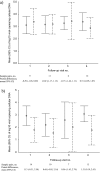Viral load in the natural history of human papillomavirus type 16 infection: a nested case-control study
- PMID: 21415020
- PMCID: PMC3080901
- DOI: 10.1093/infdis/jir049
Viral load in the natural history of human papillomavirus type 16 infection: a nested case-control study
Abstract
Background: Viral load may influence the course of human papillomavirus type 16 (HPV-16) infection.
Methods: This case-control study was nested within the 2-year Atypical Squamous Cells of Undetermined Significance and Low-Grade Squamous Intraepithelial Lesion Triage Study, in which women were followed semiannually for HPV and cervical intraepithelial neoplasia (CIN). Case patients (n = 62) were women diagnosed with CIN3 following HPV-16-positive detection at a follow-up visit. HPV-16-positive controls (n = 152) without CIN2 or CIN3 were matched to cases based on the follow-up visit in which viral load was measured. Real-time polymerase chain reaction was used for HPV-16 DNA quantification.
Results: The risk of CIN3 increased with increasing HPV-16 DNA load at the follow-up visit (odds ratio, 1.63; 95% confidence interval, 1.33-1.99 per 1 log(10) unit increase); the association was not affected by whether HPV-16 was present at enrollment. When HPV-16 was present at both enrollment and follow-up, viral load remained high among cases (P = .77) but decreased substantially among controls (P = .004). Among women with HPV-16 found initially during follow-up, viral load in the first HPV-16-positive sample was associated with short-term persistence; load was higher in those with infection, compared with those without infection, 1 visit after the initial positivity (P = .001).
Conclusions: Viral load of newly detected infections and changes in viral load predict persistence and progression of HPV-16 infections.
Figures


References
-
- Bosch FX, Manos MM, Munoz N, et al. Prevalence of human papillomavirus in cervical cancer: a worldwide perspective. International Biological Study on Cervical Cancer (IBSCC) study group. J Natl Cancer Inst. 1995;87:796–802. - PubMed
-
- Nobbenhuis MA, Helmerhorst TJ, van den Brule AJ, et al. Cytological regression and clearance of high-risk human papillomavirus in women with an abnormal cervical smear. Lancet. 2001;358:1782–3. - PubMed
-
- Franco EL, Villa LL, Sobrinho JP, et al. Epidemiology of acquisition and clearance of cervical human papillomavirus infection in women from a high-risk area for cervical cancer. J Infect Dis. 1999;180:1415–23. - PubMed
-
- Syrjanen S, Shabalova IP, Petrovichev N, et al. Clearance of high-risk human papillomavirus (HPV) DNA and Pap smear abnormalities in a cohort of women subjected to HPV screening in the New Independent States of the former Soviet Union (the NIS cohort study) Eur J Obstet Gynecol Reprod Biol. 2005;119:219–27. - PubMed
Publication types
MeSH terms
Substances
Grants and funding
LinkOut - more resources
Full Text Sources
Other Literature Sources
Medical

